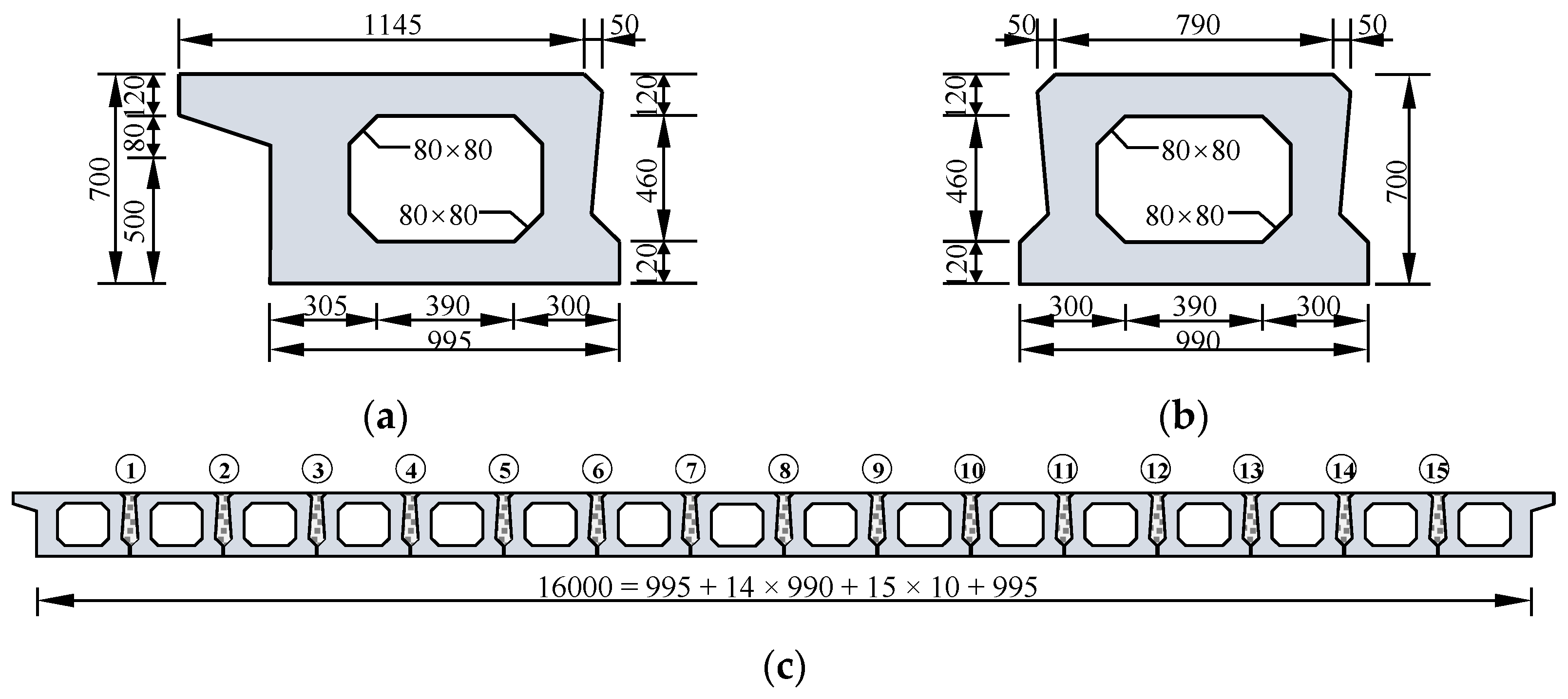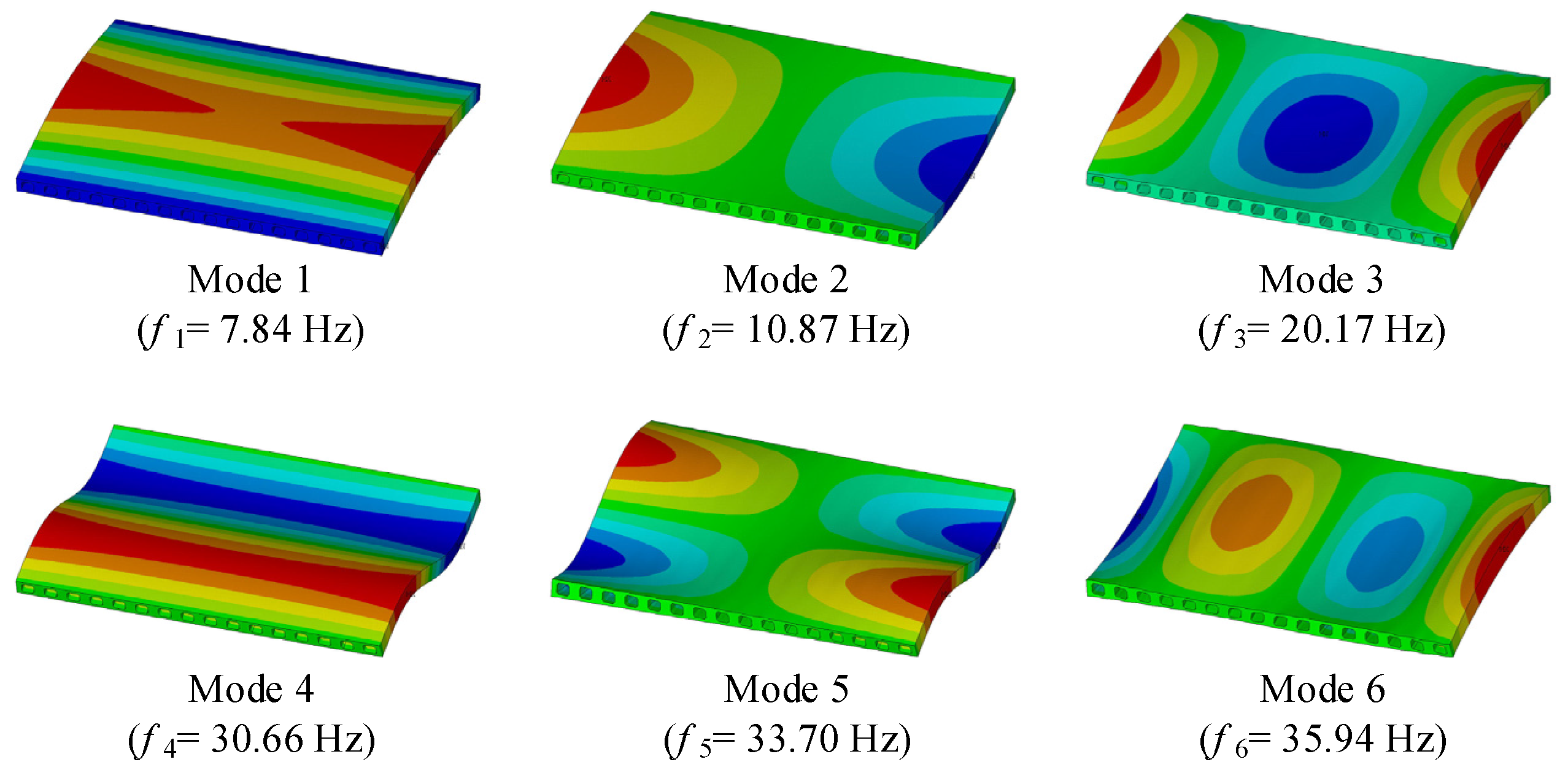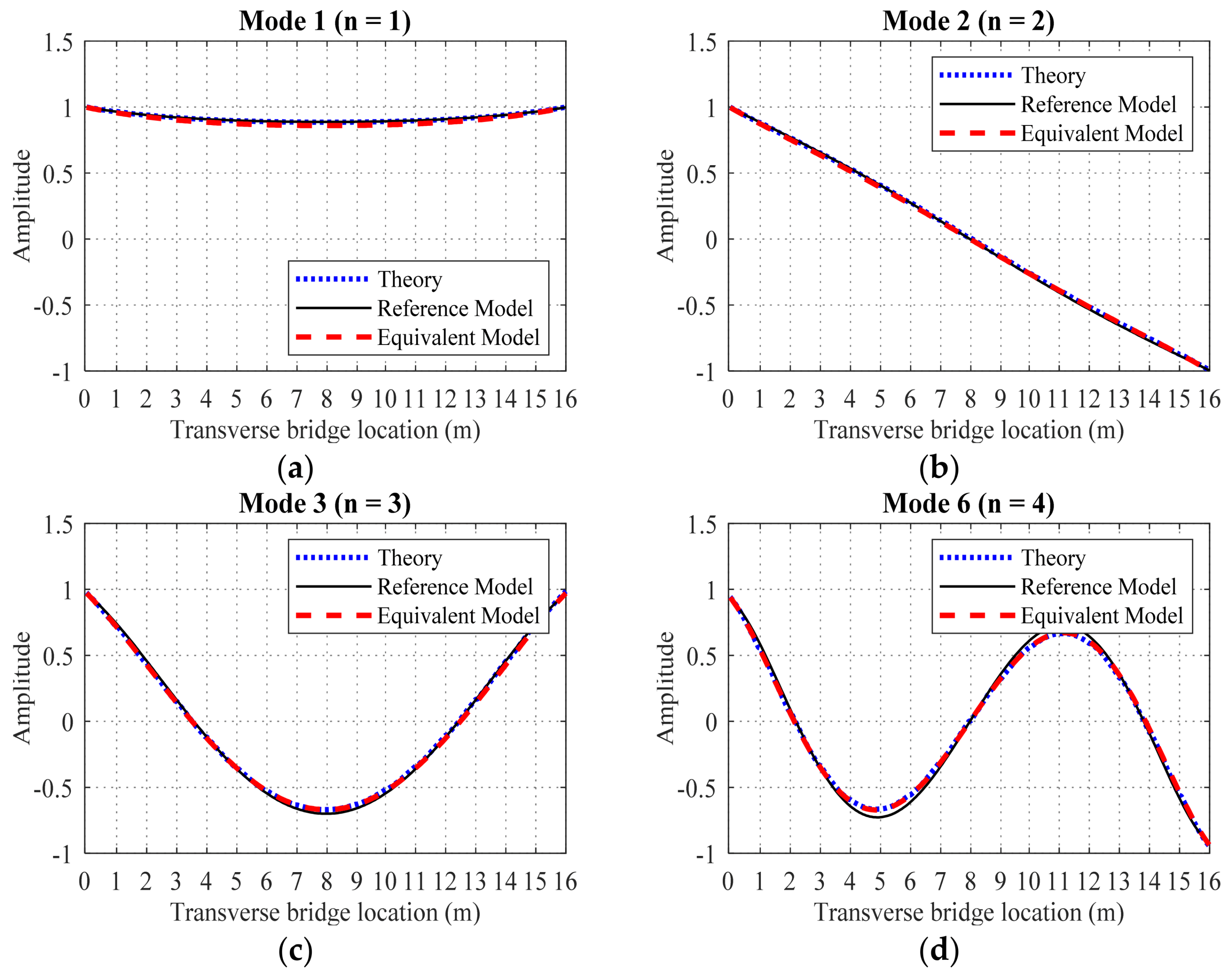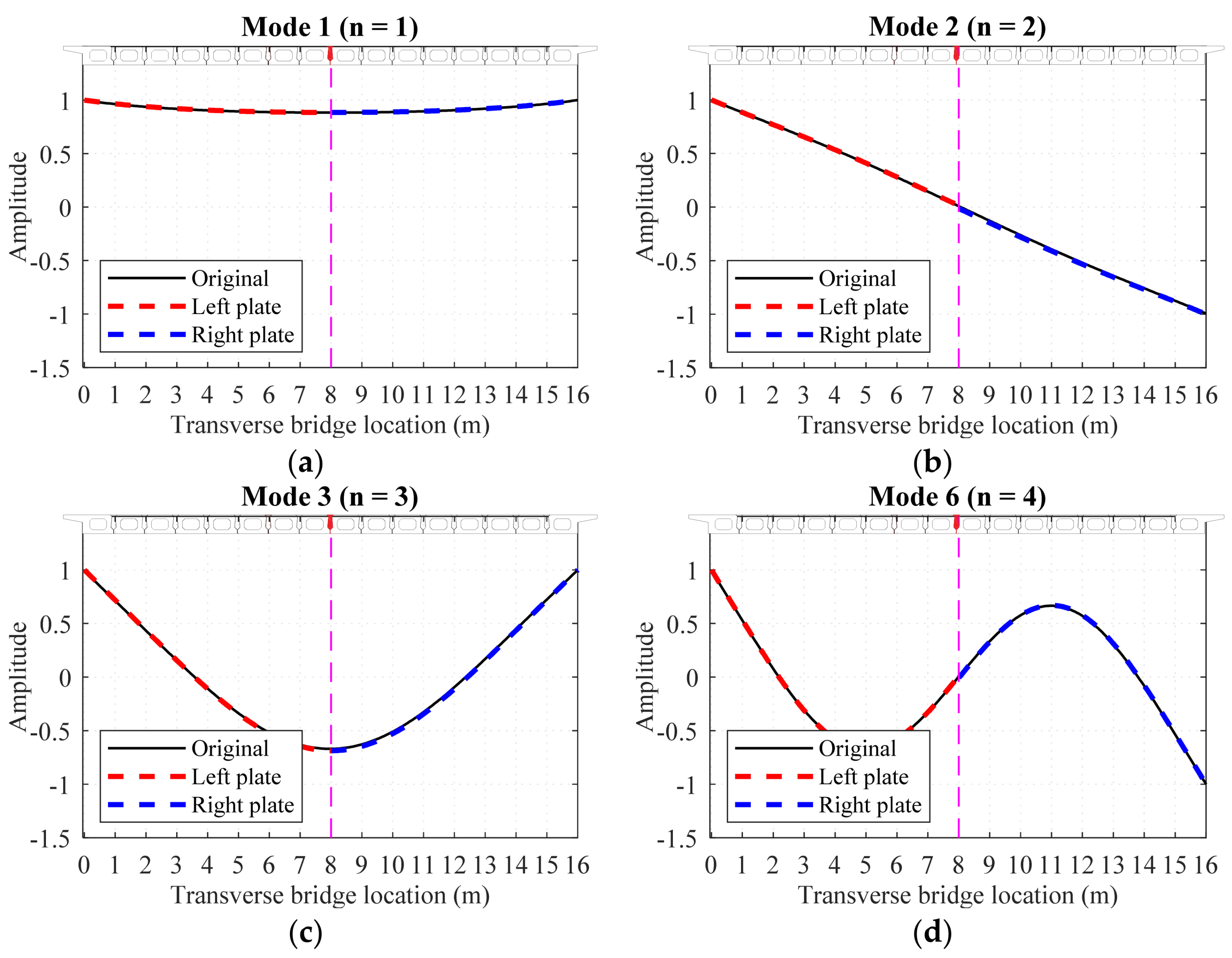Equivalent Solution Method for the Analytical Transverse Modal Shape of Hollow Slab Bridges
Abstract
:1. Introduction
2. Dynamic Characteristics of Hollow Slab Bridge
2.1. Structure and Mechanical Characteristics
2.2. Reference Model
3. Analytical Solution of the Modal Shape of a Hollow Slab Bridge
3.1. Dynamic Equivalent Model
3.2. Analytical Solution of Modal Shape
3.3. Equivalent Boundary of Hinge Joint
4. Discussion
4.1. Modal Analysis Results
4.2. Modal Shape Verification under Elastic Boundary
5. Conclusions
- (1)
- By comparing the results of the solid model, equivalent model, and the theoretical calculation of the hollow slab bridge, the relative error of the first six frequencies was less than 5%, and the coincidence degree of the first four transverse modal shapes was very high, which indicates that the equivalent model can accurately reflect the vibration characteristics of a solid model of a hollow slab bridge; the analytical solution based on Kirchhoff thin plate theory can also accurately describe the first four transverse modal shapes;
- (2)
- The original structure is divided into two plates with elastic supporting boundaries and considering the hinge joints as the elastic boundary conditions. By solving the analytical form of the transverse modal shapes of the plate structure (simply with supported edges, free edges, and elastic supported edges) and comparing them with the transverse modal shapes of the original structure, it was verified that the local structure, with an equivalent elastic support boundary of the hinge joints, can reflect the modal shape of the original structure, indicating that the partial structure with an elastic support boundary can be used to study the hinge joints;
- (3)
- The analytical solution of the mode shape of an orthotropic plate with an elastic support boundary shows that its transverse mode shape is mainly contributed to by the equivalent elastic embedded spring, and the influence of the elastic shear spring on the transverse mode shape can be neglected;
- (4)
- When the location selection of the elastic support boundary (equivalent to the hinge joint) makes the transverse size of one of the local structures too small, it no longer meets the requirement of thin plates, yet the analytical solution of the transverse modal shape obtained based on Kirchhoff thin plate theory can still well match the modal shape of the original structure.
Author Contributions
Funding
Data Availability Statement
Acknowledgments
Conflicts of Interest
References
- Qu, C.; Yi, T.; Li, H. Modal identification for superstructure using virtual impulse response. Adv. Struct. Eng. 2019, 22, 3503–3511. [Google Scholar] [CrossRef]
- Qu, C.; Mei, D.; Yi, T.; Li, H.N. Spurious mode distinguish by modal response contribution index in eigensystem realization algorithm. Struct. Des. Tall Spec. Build. 2018, 27, e1491. [Google Scholar] [CrossRef]
- Qu, C.; Yi, T.; Yao, X.; Li, H.N. Complex frequency identification using real modal shapes for a structure with proportional damping. Comput.-Aided Civ. Infrastruct. Eng. 2021, 36, 1322–1336. [Google Scholar] [CrossRef]
- Zhang, J.; Yi, T.; Qu, C.; Li, H.N. Determining orders of modes sensitive to hinge joint damage in assembled hollow slab bridges. J. Bridge Eng. 2022, 27, 04022001. [Google Scholar] [CrossRef]
- Omar, E.; Mahmoud, E.; Ayman, K. Behaviour of prestressed hollow core slabs strengthened with NSM CFRP strips around openings: A finite element investigation. Eng. Struct. 2021, 238, 112262. [Google Scholar]
- Yi, H.; Li, C.; Dai, L. Experimental study on the shear performance of shallow hinge joints for prefabricated hollow slab bridges. Adv. Struct. Eng. 2018, 2018, 3962942. [Google Scholar] [CrossRef]
- Zhan, J.; Gao, S.; Yan, Y.; Zhou, Y. A Calculation method for transverse load distribution coefficient of highway simply-supported slab-girder bridges based on model updating. China J. Highw. Transp. 2019, 32, 72–79. [Google Scholar]
- Peng, A.; Dan, H.; Yang, D. Experiment and numerical simulation of the dynamic response of bridges under vibratory compaction of bridge deck asphalt pavement. Math. Probl. Eng. 2019, 2019, 2962154. [Google Scholar] [CrossRef] [Green Version]
- Shad, M.S.; Kenneth, K.W.; Husam, H.H.; Al Rikabi, F.T.; Steinberg, E.P. Modeling the shear connection in adjacent box-beam bridges with ultrahigh-performance concrete joints. II: Load transfer mechanism. J. Bridge Eng. 2017, 22, 04017044. [Google Scholar]
- Zhan, J.; Zhang, F.; Siahkouhi, M.; Kong, X.; Xia, H. A damage identification method for connections of adjacent box-beam bridges using vehicle-bridge interaction analysis and model updating. Eng. Struct. 2021, 228, 111551. [Google Scholar] [CrossRef]
- Dan, D.; Xu, Z.; Zhang, K.; Yan, X. Monitoring index of transverse collaborative working performance of assembled beam bridges based on transverse modal shape. Int. J. Struct. Stab. Dyn. 2019, 19, 1950086. [Google Scholar] [CrossRef]
- Wen, X.; Lei, W.; Dan, D.; Liu, G. Study on a measurement index of transverse collaborative working performance of prefabricated girder bridges. Adv. Struct. Eng. 2017, 20, 1879–1890. [Google Scholar] [CrossRef]
- Xiang, C.; Li, L.; Zhou, Y.; Dang, C. An efficient damage identification method for simply supported beams based on strain energy information entropy. Adv. Mater. Sci. Eng. 2020, 2020, 9283949. [Google Scholar] [CrossRef]
- Liu, H.; He, X.; Jiao, Y. Damage identification algorithm of hinged joints for simply supported slab bridges based on modified hinge plate method and artificial bee colony algorithms. Algorithms 2018, 11, 198. [Google Scholar] [CrossRef] [Green Version]
- Jiang, H.; Dong, X.; Fang, Z.; Xiao, J.; Chen, Y. Experimental study on shear behavior of a UHPC connection between adjacent precast prestressed concrete voided beams. J. Bridge Eng. 2020, 25, 04020106. [Google Scholar] [CrossRef]
- Xu, Z.; Dan, D.; Deng, L. Vibration-based monitoring for transverse cooperative working performance of assembled concrete multi-girder bridge: System design, implementation and preliminary application. Int. J. Struct. Stab. Dyn. 2021, 21, 2150043. [Google Scholar] [CrossRef]
- Shen, Q.; Kang, A.; Xiao, P.; Gu, W.; Jin, D.; Chen, X. Applied research on hinged joint damage evaluation of hollow slab bridge based on acceleration amplitude ratio. In Proceedings of the 3rd International Symposium on Application of Materials Science and Energy Materials (SAMSE 2019), Shanghai, China, 30–31 December 2019. [Google Scholar]
- Hsu, M. Vibration analysis of orthotropic rectangular plates on elastic foundations. Compos. Struct. 2010, 92, 844–852. [Google Scholar] [CrossRef]
- Au, F.T.K.; Wang, M.F. Sound radiation from forced vibration of rectangular orthotropic plates under moving loads. J. Sound Vib. 2005, 281, 1057–1075. [Google Scholar] [CrossRef]
- Lévy, M. Mémoire sur la théoric des plaques élastiques planes. J. Math. Pures Appl. 1877, 30, 219–306. [Google Scholar]
- Cao, Z. Vibration Theory of Plates and Shells; China Railway Publishing House: Beijing, China, 1989. [Google Scholar]
- Huffington, N.J., Jr.; Hoppmann, W.H., II. On the transverse vibrations of rectangular orthotropic plates. J. Appl. Math. 1958, 25, 389–395. [Google Scholar] [CrossRef]
- Clough, R.W.; Penzien, J. Dynamics of Structures; McGraw-Hill: New York, NY, USA, 1975. [Google Scholar]












| Mode Number | Order of Longitudinal Direction | Order of Transverse Direction | Reference Model | Equivalent Model | Rayleigh Method | ||
|---|---|---|---|---|---|---|---|
| m | n | fr(Hz) | feq(Hz) | fth(Hz) | Δeq | Δth | |
| 1 | 1 | 1 | 7.84 | 7.77 | 7.78 | 0.94% | 0.77% |
| 2 | 1 | 2 | 10.87 | 10.59 | 10.52 | 2.52% | 3.22% |
| 3 | 1 | 3 | 20.17 | 19.98 | 20.07 | 0.98% | 0.50% |
| 6 | 1 | 4 | 35.94 | 37.63 | 38.14 | −4.72% | −6.12% |
Publisher’s Note: MDPI stays neutral with regard to jurisdictional claims in published maps and institutional affiliations. |
© 2022 by the authors. Licensee MDPI, Basel, Switzerland. This article is an open access article distributed under the terms and conditions of the Creative Commons Attribution (CC BY) license (https://creativecommons.org/licenses/by/4.0/).
Share and Cite
Qu, C.; Gong, Y.; Ren, L.; Zhang, R.; Li, H. Equivalent Solution Method for the Analytical Transverse Modal Shape of Hollow Slab Bridges. Mathematics 2022, 10, 3977. https://doi.org/10.3390/math10213977
Qu C, Gong Y, Ren L, Zhang R, Li H. Equivalent Solution Method for the Analytical Transverse Modal Shape of Hollow Slab Bridges. Mathematics. 2022; 10(21):3977. https://doi.org/10.3390/math10213977
Chicago/Turabian StyleQu, Chunxu, Yachao Gong, Liang Ren, Rui Zhang, and Hongnan Li. 2022. "Equivalent Solution Method for the Analytical Transverse Modal Shape of Hollow Slab Bridges" Mathematics 10, no. 21: 3977. https://doi.org/10.3390/math10213977






